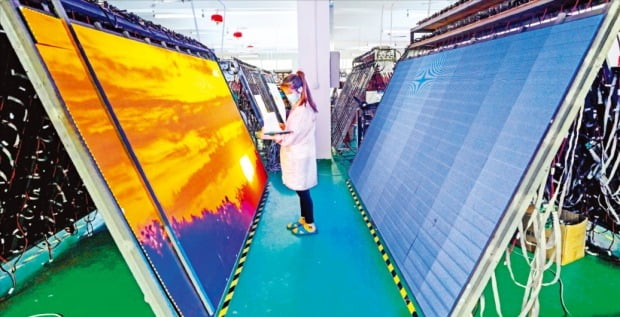
The phenomenon of’supply shortage’ is spreading, as the production of major electronic components such as semiconductors, LCD/OLED panels, and MLCCs cannot keep up with demand. The picture shows an employee of a display company in Shenzhen, China, inspecting an LED panel. yunhap news
Korea’s leading electronics company A is planning to add Chinese LCD (liquid crystal display) panel maker C, which is evaluated as ‘2nd tier’, as a supplier. This is because it is not possible to produce as many products as desired only with parts supplied by existing customers. Company A decided to drastically reduce the quality verification period that normally takes’one year or more’ to quickly designate a supplier.
The’short supply’ airflow that started in semiconductors is spreading to all industries. The supply of key components for information technology (IT) and home appliances such as LCD/OLED (organic light-emitting diode) panels, MLCC (multilayer ceramic capacitors), LED chips, secondary batteries, and ABS (high value-added synthetic resins) failed to keep up with demand. ‘It is a situation to be worried about. The demand for parts increased due to the expansion of’rebound consumption’ and anticipation of an economic recovery due to the development of a novel coronavirus infection (Corona 19) vaccine.
○ Chinese smartphones, production disruption due to lack of MLCC
According to related industries on the 27th, LG Display recently raised its utilization rate to 100%. Due to the influence of working from home, orders for LCD panels for laptops and monitors are pouring. A company official said, “The world’s LCD panel makers are in’fully operational’ state.”

Samsung SDI is similar. The company’s cylindrical batteries are used in power tools and Tesla electric vehicle batteries such as Milwaukee in the US and Bosch in Germany. As demand for power tools has increased due to the recent economic recovery, orders are flooding. In the industry, it is said that “the situation is full of orders to the bottom of the chin.”
MLCC, which is referred to as’industrial rice’, is in a state of’short supply’ as it contains as many as 10,000 electric cars and smartphones. Chinese smartphone makers, such as Oppo and Vivo, are largely influenced by the sharp increase in orders from the second half of last year. Norio Nakajima, president of Murata, the world’s number one company, said in Bloomberg last month that “the production is not taking place on holidays.” Chinese smartphone makers with poor purchasing power are already disrupting production.
○ Laptop’temporarily out of stock’
Due to the rapid increase in parts orders, smartphone and TV makers are also having difficulty securing parts. These companies are focusing on securing alternative customers to prevent the worst situation of’cutting production’.
Samsung Electronics is using Taiwanese MediaTek chips for mid- to low-end smartphones instead of its own communication chips. Following the application processor (AP) of Taiwan MediaTek in the Galaxy A32 released last year, the Galaxy A12, a low-cost phone recently released in the UK, also adopted the MediaTek chipset. It is known that the impact of short supply of its own chips was largely due to shortage of semiconductors.
Home appliance makers are currently under tension over the supply and demand of ABS, which is used as a container for products. An official from the home appliance company said, “We have not received enough ABS from the end of last year, but the shortage will continue throughout the first half.”
Laptop makers, whose orders are rushing due to the impact of working from home, are in a hurry to appease customers’ desire, “When will they arrive?” It is known that laptops such as Taiwan’s Acer and Asus can only be received after 2 months of order. The impact of the shortage of CPUs and LCD panels of AMD in the US is large.
There are also cases of outsourcing production to competitors due to lack of products. It is reported that Samsung Electronics’ System LSI Division has entrusted the production of some of the image sensors used in smartphones to Taiwan’s UMC, not its own factory. The foundry division’s plant is fully operational, but there is no room for additional supply due to orders from other external companies.
○ It will take more than 6 months to normalize supply and demand
The reason for the supply shortage is that parts makers started to invest in’conservative’ facilities due to the spread of Corona 19 last year. The world’s top three semiconductor companies, such as Intel, SK Hynix, and Micron, also reduced their facility investment by 10 to 30% compared to the previous year. In this situation, when the demand for parts exploded, a’shortage’ phenomenon occurred.
Parts makers such as TSMC plan to expand capacity this year, but it is evaluated that their limitations are clear. This is because even investing in production facilities now takes at least 6 months to 1 year for mass production. Ahn Ki-hyun, executive director of the Korea Semiconductor Industry Association, said, “The shortage of semiconductor supply has begun now and may last for more than three years.”
Reporter Hwang Jeong-soo [email protected]
